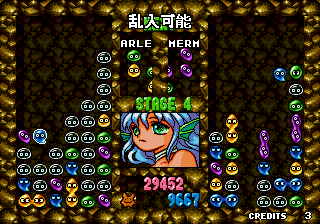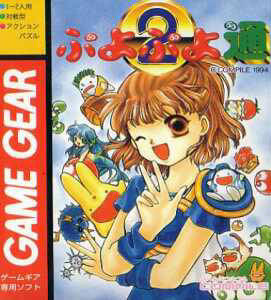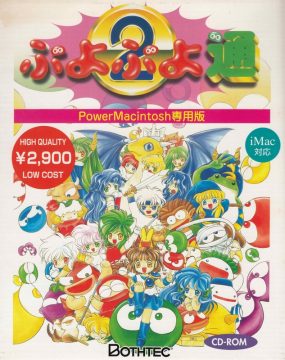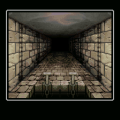From this point onward, Compile started using puns with the numbering in the titles: Tsuu is the phonetic Japanese pronunciation of the English word “two”, but the kanji used means “passing through” in Japanese.
There are a number of mechanical changes to Puyo Puyo Tsuu. There’s the ability to turn a pair of falling Puyo upside down when it gets in between two columns, allowing you to potentially undo a fatal mistake. There’s a huge boost to the power of the next chain (in addition to a point bonus) after clearing the board of all Puyo, which rewards players for planning ahead strategically. There’s a sudden-death mechanic that makes almost every single chain lethal after a certain amount of time has passed in a match (while the power of regular chains has been reduced slightly), as well. Also, the “next Puyo” indicator shows a preview of the next two sets of Puyo, to reduce guesswork and make planning chains a little easier.
Even though these were all great changes, what really made the series as a whole start to take huge steps forward is the mechanic of offsetting. It’s a rather simple concept: if you have Nuisance Puyo ready to come down and mess up your board, all you have to do is set off a chain. Doing so lessens the amount of Nuisance Puyo, and if your chain is strong enough or high in number, erase them altogether and even send more back to your opponent.
While simple, the impact of this mechanic is huge, and results in vastly different matches compared to the previous game. Now it isn’t just about making chains faster, but about using your sets of Puyo better than your opponent, having strategies to counter offensives at bad times, assessing the strength of your opponent’s chain to see if it mattered and if yours was larger in size at a glance, and so on. With all these changes combined, the competitive side of the series exploded, making Puyo Puyo Tsuu one of the most popular entries.
The regular arcade mode also differs a bit from its predecessor in terms of progression. Instead of just going up against a sequence of foes, you start at the base of a tower, with each floor sectioned off by a series of opponents, and a roulette wheel dictating which foe you face. The only way to progress to the next floor is by earning enough points on the current one. If you clear all the foes on a floor and don’t have enough points, the game is actually kind enough to give you another opponent to fight for a chance at moving on. If you beat that foe and somehow still don’t have enough points, you just get a game over. You have a lot of foes to face on the first few floors, though, so this shouldn’t happen too often until the later stages, where the number of foes decreases.
Since the drop speed of Puyo only increases with the amount of rounds, and it’s easy to have a small number of rounds to complete by gaining a lot of points, the game tends to be a little easier than the first one. However, in order to fight the true final boss, you have to go throughout the game without getting a game over, which is quite difficult, to say the least. Unfortunately, the extended campaign comes at the cost of the fun cutscene interactions. Instead of having dialog between two characters like the original game, there’s just a short description of the character you’re facing.
New characters
Scylla
Body of a dog, torso of a woman. She’s apparently a kleptomaniac, though this trait isn’t shown much in the Saturn and PlayStation ports.
Incubus
He considers himself a “ladies’ man” (which is natural, seeing as he’s an incubus), but fails horribly every time he encounters Arle, no matter what game. He has a tendency to speak in English: When you defeat him, he says “Oh my god”.
Cockatrice
Instead of being the body of a dragon with the head of a rooster, it’s just a body and head of a rooster – the only dragon part of him is his tail. The four-letter abbreviation of his name in battle is COOK, obviously to avoid profanity.
Will-o-wisp
A wisp that’s so bright that Arle wears sunglasses around it. It doesn’t make many appearances in later games, so you don’t get to see what makes him special, if there is anything.
Trio the Banshee
A trio of banshees. They actually have pretty varied personalities and names to boot, though they pretty much act the same in the saturn and PlayStation ports.
Nomi
A flea – that’s what “nomi” means, after all. An arrow always points to him since it’s pretty difficult to see him otherwise, and he’s quite easy to beat, since he’s a flea and all. There’s text above his head sometimes that means “he’s here”.
Momomo
One of the merchants in this game (there’s quite a few of them), who breaks the fourth wall and tries to sell Arle Puyo Puyo merchandise.
Kid Zombie
A kid zombie, most likely related to Zombie. In the cutscene when you meet him, his entire head falls apart.
Seriri
A mermaid that’s afraid that everyone will eat her due to hearing some rumor that eating a mermaid grants immortality. Her name changes around a bit – the game refers to her as Uroko Sakana Bito (which means scaly fish person), but the abbreviation when you fight her is MERM (for mermaid), and she’s eventually called Seriri later.
Nohoho
The second merchant character, who has a love for curry. He sets an AI trend that never leaves the series, in which he’ll stack Puyo to the sides of the screen as fast as possible. This can sometimes give him a set up for good chains, but it mostly just wastes time and gives you an advantage.
Cait Sith
Twin Siamese cats – a play on the term “Siamese Twins”. Since they’re twins, they always complete each other’s sentences.
Fufufu
Instead of becoming a sweet dancer like the other fish, this one decided to become the third merchant. He says “fufufu” quite a bit – even though it’s his name, it comes off as him attempting to be sinister.
Owlbear
The body of a bear combined with the head of an owl, who happens to be a friend of Seriri. There’s not much that makes him stand out, though in a cutscene with him, he crashes headfirst into a pillar and makes it fall, not seeming fazed in the slightest.
Samurai Mole
A mole that decided to take up the title of a samurai. He’s polite when you face him, and he uses samurai words in his scenes.
Parara
The last merchant. For some reason, even though you face him late in Expert mode, he doesn’t rotate his Puyo at all.
Mamono
Mamono means “demon”, so you can probably guess what this guy is. He’s actually rather creepy and intimidating, though he does cry when he loses.
Since Compile once again cooperated with Sega for the arcade version, the Mega Drive port is the truest conversion. The only problem is that the quality of the music and voices is reduced slightly. On top of that, the music pauses whenever a character says a line. There’s an option in the menu that allows the voices to be played during the music, but at a great expense to the quality of said voices.
Multiple ports came afterwards, which brought many changes and additions to the game. The PC Engine CD port is almost identical to the Mega Drive one, but it lacks stage backgrounds and the animations aren’t as fluid. It makes up for this with the usual voice acting, so the character descriptions are now read out loud by a narrator.
The first Super Famicom version, Super Puyo Puyo Tsuu, ups the ante by offering players multiple stages of play, varying in difficulty, and also doesn’t suffer from the voice problem. It has a few other additions – not only does it have practice mode, but it’s the first game in the series to feature a four-player mode, although it makes each player’s field absolutely tiny. It also brings back the cutscenes, but due to the stage rotation in the standard single-player mode, it’s not as easy to get to see them all.
The 32-bit ports are substantially reworked, including the story mode; now, characters talk before a battle, just like in the first game, with fully voiced lines and some expressive sprite work to go with it. The cutscenes are even different from the SFC port, surprisingly. This all gives the numerous characters a chance to shine. Not only that, but these versions also finally give the title pun its meaning by introducing “Through” mode, where you go after every foe in the game, one after the other. With more than 30 characters to face, it’s a challenge, and rightfully so. This mode was also carried over to a second iteration on the Super Famicom, dubbed Super Puyo Puyo Tsuu Remix.
Titled Pocket Puyo Puyo Tsuu, the Game Boy version seeks to improve upon the previous portable release. Not only does every Puyo have a different shape, but also different patterns of lines and dots. This game also removes the characteristic eyes to save precious space. Unfortunately, it’s a bit difficult to read the second pair of Puyo that are coming up next, but at least this time it’s easier to tell them all apart from each other once they’re on the grid. It also gets rid of all the cutscenes seen in the Super Famicom and 32-bit versions. Thankfully, at least the “Through” mode from the later home versions is included. Finally, the music and sound quality is much improved.
Pocket Puyo Puyo Tsuu includes the usual multiplayer and endless modes, but the latter has changed a bit. It isn’t simply the peaceful “clear Puyo until you fail” mode; instead it introduces a hazard mechanic. Every few moments, a signal at the upper right corner of the screen informs you that there’s an attack coming, the strength of said attack randomly ranging from low, medium, high, and great. After the timer on the notification runs down, Nuisance Puyo are added to your queue, and drop down if you’re unable to offset them. This makes endless mode a much more difficult affair, and can certainly serve to quickly end a run. Things aren’t all bad, however; Carbuncle and Big Puyo from the very first Puyo Puyo make a return. They both function the same way as they did on the MSX2, though you’re unable to choose which one you’d like. In case this is too much to handle, though, you’re given the choice to disable these features in the options menu.
This version also made it to the Neo Geo Pocket Color, which was released in North America and Europe as Puyo Pop, marking the first time the West got a Puyo game without it being tied into some other franchise. (A Game Boy Advance version was released in North America under the same name, though it’s technically a different game called Minna de Puyo Puyo in Japan.) Although it may seem superior to the Game Boy version due to the fact that it features colors and voices, it comes at a bit of a price. The music quality is worse than on the Game Boy, and turning on voices means that you’re unable to hear any music at all.
Since it’s the most iconic of the classic Puyo Puyo games, Tsuu appeared on Volume 12 in the Sega Ages 2500 series for PlayStation 2. With the subtitle Perfect Set, it includes all content from the 32-bit versions, with the addition of all the puzzles from the two Game Gear Nazo Puyo releases, and an editor to create your own puzzles. While the game runs in the PS2’s 640×448 resolution, it doesn’t use the pixel art from the PC-98 and Windows versions, but rather retouched upscales of the original graphics.
Puyo Puyo Tsuu is also included in Sega 3D Classics Vol. 2 for 3DS. It’s a port of the arcade game with 3D visuals, and it looks pretty nice. This version was released in North America, though due to programming difficulties, the game is untranslated.
Puyo Puyo Tsuu has had a lasting impact on the series, having introduced a solid set of new mechanics, many of which have stayed with the franchise ever since. It was a huge hit at the time of its release, almost to the level of Street Fighter II, and sold tons of copies. While it may seem a bit dated now since there have been more refinements afterwards, it’s still arguably the “purest” Puyo Puyo game.





